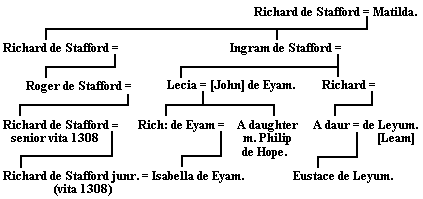The Staffords of Eyamby C. E. B. BOWLES, M.A.This article was published originally in the Derbyshire Archaeological Society Journal, vol. 30, 1908; pp261-295. This transcription by Rosemary Lockie © 2000-1
I. - RICHARD DE STAFFORD is the first member of this family on record. It has not hitherto been found possible to connect him with the great baronial family, ancestors of the Dukes of Buckingham, who took their name from the important capital and castle of the neighbouring county, in which their chief possessions were situated. Considering the date at which apparently he suddenly springs into existence, he would, if related in any degree, be either a son or a very near relation of Nicholas, second Baron de Stafford. But although there is evidence of some armorial identification, it is quite possible that the two families were distinct. The Staffords of Botham, near Glossop, County Derby, however, who bore the same arms as the Staffords of Eyam, with a mullet for a difference, almost certainly sprung from the Baronial stock. Judde Stafford, of Botham, the first in the Visit. of 1662, formed one of the Jury in a Bradshaw suit, 1499.[4] The document on which is based the existence of Richard de Stafford as a landowner of Eyam is without date, but was probably executed soon after his death, early in the reign of Henry III. That which warrants the assertion that he was the progenitor of a long line of landed proprietors, whose acres grew by means of their marriages, was printed in the Derbyshire Archaeological Journal for 1901, vol. xxiii., under the title, “Proceedings taken in Winster Church regarding the consanguinity of the parties to the marriage of two of the Staffords of Eyam, 1308”. The original, in the possession of the writer, a fac-simile of which forms the frontispiece of that volume, has proved most valuable to the genealogist, as it supplies a pedigree of no less than five [Page 263] generations, dating from the time of King John. As the proceedings in Winster Church took place in 1308, a rough calculation, giving an allowance of thirty years to each generation, would warrant the supposition that the said Richard de Stafford was living in Eyam about the year 1200. Who he was, from whence he came, as well as when he died, are still matters for conjecture. That he had two sons, Richard and Ingram, by his wife, Matilda, is ascertained from the manuscript[5] before alluded to, from which the following pedigree is obtained:-  Thus we see that Richard was the heir, and that Ingram, the second son, had issue (i.) one son, Richard, whose daughter married and was the mother of one Eustace de Leam; and (ii.) a daughter, Lecia, who married John de Eyam, and whose son, Richard de Eyam, was father of Isabella, and that it was her marriage with Richard de Stafford, jun., which was the subject of the proceedings of 1308. |
|||||||||||||